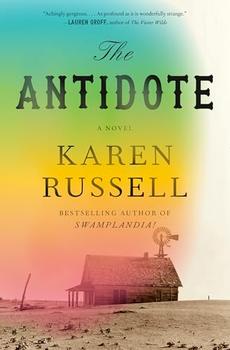Summary | Excerpt | Reviews | Beyond the Book | Read-Alikes | Genres & Themes | Author Bio

A Novel
by Karen RussellThis article relates to The Antidote
 One of the protagonists in The Antidote is Cleo Allfrey, a photographer dispatched by the Resettlement Administration to document life in Nebraska's Dust Bowl. She and others in the book mention a similar, real-world project: a documentary titled The Plow That Broke the Plains.
One of the protagonists in The Antidote is Cleo Allfrey, a photographer dispatched by the Resettlement Administration to document life in Nebraska's Dust Bowl. She and others in the book mention a similar, real-world project: a documentary titled The Plow That Broke the Plains.
The Plow That Broke the Plains was a controversial, federally funded film that explored the causes behind the Dust Bowl. In the time of the booming demand for grain during and right after World War I, Midwestern farmers looked for ways to improve their land's yield. In the Great Plains in particular—a grassland prairie ecosystem that stretches across the middle part of the United States—one method was to plow up native grasses so more wheat could be planted. By 1930, some 5.2 million acres of grassland had been converted to farmland.
However, these years of prosperity were followed by a crash in wheat prices, as well as an intense, eight-year drought. No longer anchored by prairie grass, the now-exposed soil blew away into dust. It's estimated that 850 tons of topsoil were lost to the wind in 1935 alone. Crops failed and dust storms—aka "black blizzards"—became more common, making it nearly impossible to live in the region.
Part of FDR's New Deal, a series of reforms to provide economic relief during the Great Depression, was a proposed program that would help farmers move West to more prosperous lands. However, this program was expensive and not well-supported in Congress. The Resettlement Administration subsequently began a propaganda campaign to photograph the devasted land and its people, using the bleak images to influence Congressional votes to approve it. One part of this campaign was the documentary that would become The Plow That Broke the Plains.
The RA recruited author and film critic Pare Lorentz to direct the documentary. The project ran into problems right from the start. Lorentz, who had never made a movie before, hired professional camera crews but gave them little direction, which led to conflicts between cinematographers. Lorentz had estimated the film would cost $6,000 to produce, which the RA agreed to, but quickly went over budget. He paid farmers in cash to drive their tractors while he filmed but neglected to get approval for the expenditure. He'd planned to use Hollywood stock images, but the studios were uncooperative, which forced him to do more filming than planned. He hired opera composer Virgil Thompson (who'd never written a movie score) to write the background music, and hired the New York Philharmonic to record it. Metropolitan Opera baritone Thomas Chalmer was chosen to read the narration, which was written by Lorentz. Expenses eventually totaled $20,000. Lorentz and his wife paid the overage.
The 28-minute documentary was first played to President Roosevelt in March 1936 and had its public debut at Washington's Mayflower Hotel in May. It received great reviews and considerable press coverage, but many theaters dismissed it as government propaganda and refused to air it. Lorentz got around the Hollywood snub by holding screenings across the country for local press, who in turn often hyped the film. It was eventually booked in 3,000 movie houses and was seen by an estimated 10 million people in 1937 alone.
The film was instantly controversial. Throughout the documentary, Lorentz blamed mechanized agriculture for the Dust Bowl and indicated grasslands in general were unsuited for agriculture. Those who felt the farmers themselves were to blame for exploiting the land for their own greed, with no concern for the environment, thought the director's focus was misguided. On the other end of the spectrum, some felt the farmers were being unfairly targeted. They saw them as good stewards of the land, but victims of an unusual drought. Still others criticized the movie for making it seem the entire Midwest was a vast dust bowl when only a certain portion of the territory was actually affected.
Regardless, the documentary went on to become one of the most widely viewed films in American history. Importantly, it focused discussion on the future of the Great Plains and underscored the need for a comprehensive soil conservation program. The Plow That Broke the Plains was removed from circulation in 1939 but made available to the public again in the 1960s, and in 1999 it was named to the National Film Registry. It's still shown across the country today to illustrate the economic and environmental disasters that struck the Great Plains in the 1930s. You can view it online.
Filed under People, Eras & Events
![]() This article relates to The Antidote.
It first ran in the March 12, 2025
issue of BookBrowse Recommends.
This article relates to The Antidote.
It first ran in the March 12, 2025
issue of BookBrowse Recommends.
Your guide toexceptional books
BookBrowse seeks out and recommends the best in contemporary fiction and nonfiction—books that not only engage and entertain but also deepen our understanding of ourselves and the world around us.